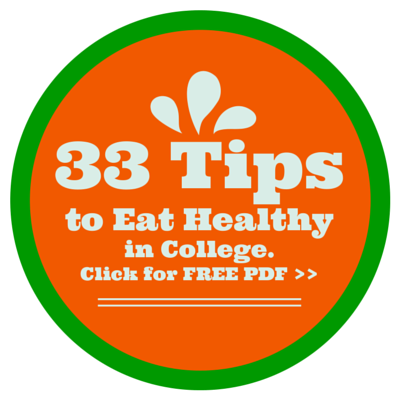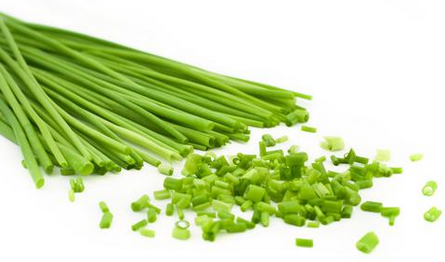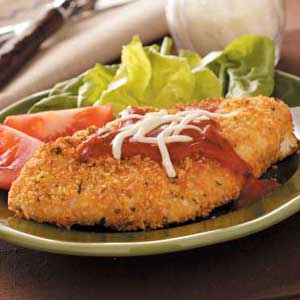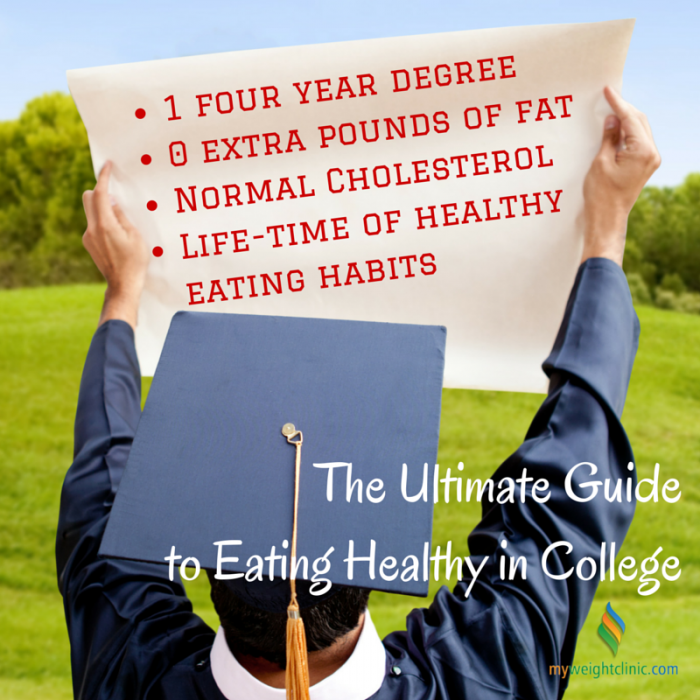
Thinking back to my freshman year on campus, how to eat healthy in college wasn't on top of my list of concerns.
Why should it be? I never had issues with weight, or health in general... in fact I was a high school athlete and always in pretty good shape.
Like thousands of former college students now neck deep in their careers, remaining ignorant on what healthy eating truly means, was a mistake I'd come to regret. After 10+ years in the health and wellness field, if I could send the ultimate advice about diet back in time to my college freshman-self, this would be it.
'How to Eat Healthy in College' is your practical guide to leveraging the latest nutritional science as a student living the college campus lifestyle.
Anyone with intense work demands, limited budget and a social life will find it just as useful.
Bookmark this page as your 'college diet survival guide'. Below, we will reveal why college makes you fat, what food traps to avoid, why beer isn't one of them, how to navigate the cafeteria, how to easily get healthy cooking skills, how to party, date, and tailgate and still be healthy, powerful advice from a Google hangout with recent college grads, how to stay fit in less than 30 minutes per week and 33 tips summing this all up.
Like food, it's best digested in small pieces, which are conveniently linked in the quick navigation table below.
Wondering how to eat healthy in college? Check this out.
Reality Check, Your College Diet Could Be Deadly
Without usable guidance based on the latest nutritional understandings, don't be surprised when half way in to your freshman year those high school jeans just can't make it past your hips anymore. That's what happened to me, but the real problem was the landslide towards metabolic disease.
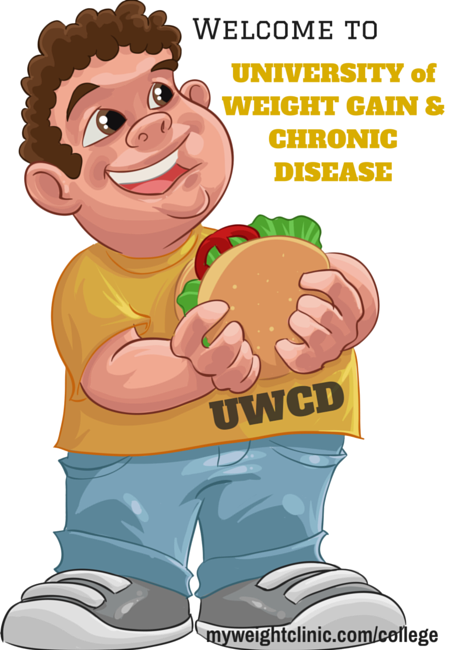
If you don't pay mind to your college eating habits they will be firmly entrenched when the chaos and stresses of your career takeover, setting you up for cardiovascular disease and diabetes before you even have a chance to think about kids.
This isn't your typical How to Eat Healthy in College Advice.
Perhaps the reason very few college kids are interested in reading about how to eat healthy in college is because most advice is generic stuff like, "eat out less, skip fatty dressings and fried foods and eat more vegetables and whole grains."
Yeah... thanks for those earth shattering revelations Einstein! You would think the fact that we are college students would mean we get the benefit of the doubt to figure basic healthy eating concepts out. The problem is that some of this 'traditional advice' is what got our country into so much trouble in the first place.
How about some practical insights based on the latest science (not outdated nutrition mantras)?
And what about specific strategies we can use in the face of all the temptation, budget constraints and exposure to foods that drive weight gain?
Tips 1 and 2
- Your eating habits in college can be more damaging than just the freshmen 15, they can cause you pain and suffering for the rest of your life
- Learn some basic science about how food affects your body, now, while you're already in 'learning mode' and you will develop life long healthy eating habits
Latest Science FACTS That Explain Why Your College Life Packs On The Weight
Pop Quiz
What's the #1 cause of weight gain during your freshman year in college?
If you answered 'E' congratulations!
The #1 one driver of weight gain in college is a diet concentrated in processed carbohydrates, aka sugar. Sorry but it's time to burst the lowfat bubble. The latest research shows it's the over-reliance on grain or starch based foods that is driving the epidemic of metabolic disease in America, and especially the bulging waistline on college campuses.
Now, that doesn't mean that calories don't matter, or that activity levels don't matter... they certainly do. But they are not the whole story, in fact they aren't even main characters in the story.
Because were it not for overly processed, sugar-laden foods that make up most of a college students diet...
...calories, fat-intake and activity levels would not be nearly as big of a concern.
So why are carbohydrates, or sugars, the culprit? Because of the processing of grains, starches and fruits, we now ingest dramatically higher amounts of carbohydrates than at any point in prior human history.
So what? Why is that bad?
Sugar Messes Up Your Metabolism
Well, for one thing... it allows you to easily ingest higher amounts of calories. But, the impact is beyond just the calories in / calories out scope of metabolism.
Blood sugar levels are a key element to good health. Insulin is a hormone produced by your pancreas that regulates the level of sugar in your blood. If there is too much, it tells your body to store the excess sugar (glucose) as fat, for a rainy day when there is not enough sugar to burn.
The Over-Worked Pancreas
With a constant supply of processed grains and sugar resulting in over-production of insulin, your pancreas is like the radiator in this car. Only instead of shutting the car off, letting it cool, adding water and then taking it to get fixed... you just keep on driving. You know the inevitable outcome. It's no different with your body.
For most college students, that rainy day rarely comes. There is a never ending supply of glucose (bread, pizza, pasta, chips, crackers, bagels, juice, soda) which keeps your pancreas pumping insulin like an overworked Kuwaiti oil well.
This causes a condition known as hyperinsulinemia, or simply insulin levels that are too high in the body. Over time, this leads to insulin resistance. Now we are getting to the scientific core of the matter. Some experts today believe the real epidemic is not obesity, but insulin resistance that is driving the bulk of chronic disease and that obesity is really just a symptom of insulin resistance.
Sugar and processed carbohydrates is what's driving metabolic syndrome. The 4 hallmark symptoms of metabolic syndrome are excess abdominal fat, high blood pressure, high blood sugar and high blood cholesterol. Another hallmark symptom for women is polycystic ovarian syndrome or PCOS.
Tips 3 and 4
- An over-reliance on processed carbohydrates in most college diets is what drive's the 'freshman 15'
- Too much sugar/grain causes high levels of insulin, increased fat storage, leading to insulin resistance & chronic disease
7 College Food Traps and Simple Strategies To Avoid Them
There are a lot of factors that drive more processed sugar and grain into the diets of college students. But if you can do even a halfway decent job of avoiding these traps in a college campus lifestyle, you'll be way ahead of the curve.
- The Breakfast trap
- The pizza & subs trap
- The juice & junk trap
- The pasta trap
- The healthy carbs trap
- The water trap
- The no veggies trap
Pizza, subs, sandwiches, burgers... anything that has a bread-based substrate or shell is generally bad news. This doesn't mean you have to avoid them 100% of the time (although it would be fine to do so). The danger is when your meals are one of these items on a consistent basis... which unfortunately does describe most college diets.
Wondering how you could possibly get around these college diet staples? Let me introduce you to your 3 new best friends:
- Wraps - swapping bread for wraps cuts over 10g of carbs for most restaurant items. Check nutrition info though as some wraps are also up there in carbs. Make wraps yourself with the low carb/high fiber variety which is a nice way to even out those insulin bumps.
- Bunless Burgers - it might seem weird at first but once you start going bunless, you can actually taste the burger and toppings better and you will avoid that gut punch feeling afterward. There's usually access to veggie burgers wherever they serve a burger as well so same applies for vegetarians.
- Chef Salads - This is sort of what's left when you take the bread off a good sandwich. Most chef salads include ham or chicken and boiled eggs. Avocado is a nice addition with healthy fats if available. Don't ruin your efforts by piling on croutons - and if they are already in there, remove half of them. Tofu of course for vegetarians, limit portions if using rice and beans which come with a pretty high carb load, to about 1 cup. Best dressing is good old white vinegar or apple cider vinegar and olive oil... Watch out for Balsamic and Red Wine Vinegar which packs in 5 grams of sugar per serving! Learn the difference of what one tablespoon of dressing looks like vs. two.
By choosing one of these at least half the time instead of the usual sub, sandwich or burger, and limiting pizza to once or twice per week, you'll be substantially reducing your risk of not just weight gain, but metabolic disease for life.
Tips 5-11
- Get a protein-rich breakfast, minimize grain/sugar based breakfast food
- Limit pizza to 2 times per week, skip most bread & buns, add chef salads
- Avoid Juice, Soda, Energy Drinks and Sugary Snack Foods
- Pasta's cheap, but it packs the fat on. Limit portions and ensure adequate protein with it
- 4 grams carbohydrates = 1 teaspoon of sugar. No need for > 100g of carbs in a day
- Drink water. Invest in a good filter cup and have good water with you at all times.
- Get 4 cups of vegetables a day. Learn how to toss a salad with vinegar and oil.
The Beer Belly Myth
Perhaps you're surprised we didn't mention all the alcohol that is consumed on college campuses?
Drinking can of course lead to consuming excess calories and sugary beverages, so in that regard it does contribute.
But, if you're able to avoid the 7 food traps above, then those party nights won't be a major a factor.
Now, if you're binge drinking leads to daily drinking (even if short of being alcoholism) it increases the odds of storing fat on your liver and wreaking all kinds of havoc on your metabolism over time.
But drinking usually doesn't become a daily habit like that until after you graduate, start making some money and dealing with the stresses of a career and family... sorry, was that too much information?
Just keep the party nights to 1 or 2 per week and avoid the food traps. If you're studying and getting good grades you won't have enough time to drink more than that anyway.
Why it's not the Beer

Let's clear the air on this right now. Beer has alcohol, we all agree on that right? Well, we know that drinking more than a 1 -2 drinks per day of any alcoholic beverage wreaks havoc on your liver and metabolism. So in that regard, yes... you should watch your beer intake (just as you should watch your vodka, wine, and tequila intake)
However, the 'beer belly' myth is based on misinformation that beer is at the top of the glycemic index. This theory (no study has actually ever been published to test it) is based on an inaccurate assumption that beer contains high amounts of maltose. WRONG! Maltose is the fuel for the fermenting process... by the time the beer is ready to package, the maltose is mostly gone! In fact the average light beer only contains 7.5 grams of carbs. So you'd have to drink a whole six pack to get the same amount of carbs in one can of Coke. There.... you see science isn't all stacked against your college life 🙂
We also didn't mention reducing fried foods, which is one of the typical pieces of diet advice college students get. When you are avoiding the 7 traps above, fried foods are less of a threat. The war on fat is misguided and that is also starting to be realized in the mainstream nutritional circles.
We don't recommend a constant diet of fried goodies, but picking on french fries and chicken tenders isn't where you're going to make the biggest improvements. Fried chicken in a bed of romaine lettuce with a low sugar dressing, not a problem. Fried potatoes are also not what's driving that freshmen 15 or obesity in general.
Tips 12 and 13
- If you avoid the 7 food traps most of the time, occasional drinking will have limited to no effect on weight
- High quantity and frequency of any alcohol leads to problems, but beer is falsely believed to be high glycemic and most light beers contain around 7.5g of carbohyrdates
Navigating The College Cafeteria Infographic
We can guess what you're thinking at this point. "Gee this all sounds great... too bad I have no money and I'm stuck with what's served in the cafeteria... which is mostly all the stuff you say not to eat!"
Here's our quick reference info-graphic to help you stay on track.
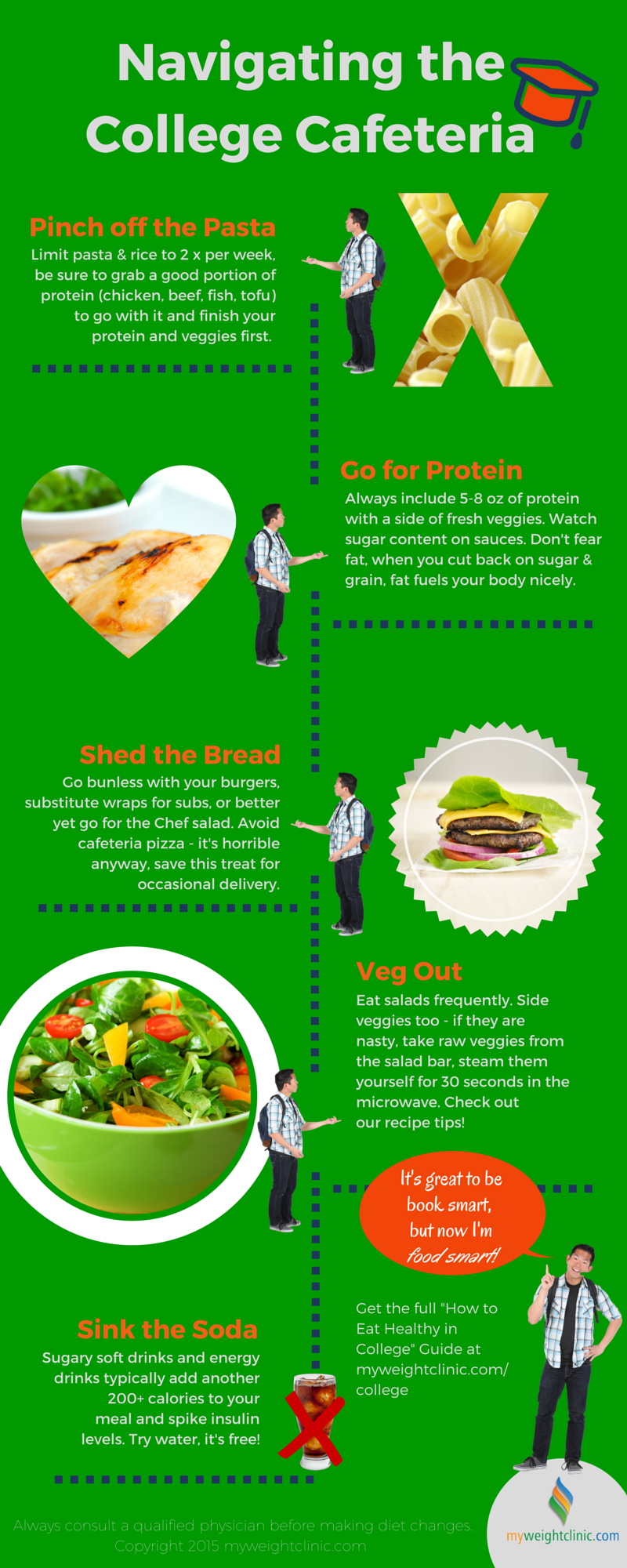
Navigating The College Cafeteria - An infographic by the team at myweightclinic.com
Embed Navigating The College Cafeteria on Your Site: Copy and Paste the Code Below
All college cafeterias are not created equal
Depending on where you go to school, the quality of the cafeteria's can vary. The trend is towards more fresh vegetables and salad bars and including vegetables into main dishes. Still, I've seen some of the cafeteria's in colleges around the country and they often leave a lot to be desired.
One of the most common complaints is the quality of vegetables available. We encourage students to voice their disapproval. You want to make a contribution to bolster your job prospects when you graduate? Get involved in improving the food choices in your college cafeteria. Seek out local farmers and see what possibilities there are for a partnership to offer their fresh, local produce in the cafeteria.
Also, when you are visiting a college campus to make a decision on where to go to school... make a point to check out the food options. If you have a couple close contenders this could be an important factor that is overlooked. "Let's see.... college A results in 4 years of metabolic disease-inducing diet, and college B sets me up for a lifetime of healthier eating." Don't overlook it or you may regret it.
Making the best of a less than stellar cafeteria selection
That being said, I've never seen a cafeteria with no veggies or salad options. You want to ensure the best quality, get there early. Try beating the rush so you get to pile up the veggies shortly after they are put out.
"...if you pile up on the Pasta Alfredo and bread sticks, and then you lather up on fudge drizzled ice milk... you're likely to become part of an insulin drug company's revenue projections."
Also, if it's apparent something is not fresh, don't be bashful. Tell them you would like some fresh veggies to brought out. Squeaky wheel gets the grease... a lesson worth learning now.
The Ice Cream Sundae Buffet
Look, we know you're going to hit that ice cream bar... so here's the key... if you've filled up on a protein and fiber rich meal, you won't be compelled to gorge on ice cream and brownies... as much. Plus, its blood sugar spiking affects will be somewhat mitigated.
But if you piled up on the pasta alfredo and bread sticks, then you lather up on fudge drizzled ice milk... you're likely to become part of an insulin drug company's revenue projections.
Take Aways (Tips 14-19)
- When you eat pasta get 5-8 ounces of lean protein and don't finish pasta before protein
- Get moderate amounts of quality protein at EVERY meal, new research strongly supports this advice
- Lower bread intake - go bunless, eat wraps and Chef Salads
- Eat 2 cups of veggies, grab from the salad bar if necessary and steam in the microwave
- Pass on the sodas, juices, and energy drinks - water is all you need
- Get adequate protein and fiber to limit the negative affect of desserts
4 Cooking Skills Every College Student Should Have
The fact that most college campus cooking amounts to slapping peanut butter and jelly between 2 slices of bread or heating up some mac & cheese is a wake up call for why students need some help with how to eat healthy in college.
These following skills are great for students who have access to cooking appliances, plus we've even included a microwave section which pretty much everyone should have access to.
You can do this, if 11 year old kids can compete on Chopped, an 18 year old can learn a few basic cooking skills.
When you're in a dorm and they are sticklers about portable stoves and offer no community kitchen, your cooking options are severely limited. We will talk about microwaves shortly, which all dorms allow, but being able to have some open heat to cook in a pan is a big plus.
How to Saute Meat
Many college students are comfortable with grilling burgers or hot dogs, but if you can't saute chicken and fish on a stove it really limits your access to superior self-prepared meals. When you pay attention to coupons and sales and stock up your freezer, you can keep a good supply of lean meats on-hand. After buying meats or veggies, portion them off into meal size and store in individual freezer bags.
And when you have some good sauteing skills you may even get your roomates to cover the costs!
Below is a helpful video from food network that gives all the basics you need to cook meat like a pro.
One of the mistakes home cooks make is not using enough spice. Even in this video it's laid on a bit thin, just ask Bobby Flay. The spice will help create a crust on the meat and give it the flavor you get when you eat in a nice restaurant.
How to Saute Vegetables
If you can get somewhat proficient at sauteing veggies, you will propel yourself up the health scale not just in college, but for life. That's because when you realize that veggies can be so darn simple and tasty anytime, you'll eat them all the time.
Not to mention that pulling off a nicely sauteed chicken and veggies meal will essentially make you a King or Queen to your roomates, and possibly your entire building :)

This tasty bag of veggies costs about 67 cents per meal.
Fresh vegetables are not the most budget friendly item in the grocery store. But, frozen veggies are less than half the cost of 'fresh' and actually they can taste as good or better in some cases. That's because frozen veggies are produced in-season, so you're getting the peak crops, whereas fresh veggies are often picked way before they are ripe.
The video below is a great introduction to get started... don't be intimidated, this is no calculus exam or even political science.
In terms of spices, just by utilizing salt, pepper and butter you'll be making some tasty veggies. If you have garlic, dried tyme or spice mixes, go for it, but don't sweat it if you don't.
A key point to note with frozen veggies is to let them completely defrost and come up to room temp before sauteing.
How to Make an Omelette
Omelettes are one of the most practical and affordable ways to produce a nutritionally ideal meal in minutes. Plus they are so flexible, you can put most anything in an omelette, or nothing .
Many college cafeteria's have an omelette stand in the morning so certainly take advantage. But, omelettes make a great lunch and dinner too. If you have a stove or can get away with a portable cook top, learning this one skill can improve your college diet handsomely.
The Perfect Omelette

- Get yourself an 8 inch frying pan, otherwise known as an omelette pan!
- Mix 2 eggs and 2-3 tablespoons of half and half or milk. You can sub water if you have issues with Milk. Add some salt and pepper. Get yourself a whisk and keeping your hand and wrist loose, whip it using a circular motion, bringing the egg up and air down into the mix, you should see it foam up a bit, this is how you get that fluffy texture.
- Get the pan hot on medium to high heat
- Slice up whatever veggies and meat you have. Peppers, tomatoes, mushrooms and onions are classics.
- Drop in a generous amount of butter. It should melt and sizzle within seconds. You cn cut with canola oil to give it a bit more staying power in the high heat.
- Throw your veggies/meats in, cook for 30 to 60 seconds.
- Pour your egg mix in
- It only takes a couple minutes to see the egg start solidifying, move the pan to get the mix swirling. Use a spatula to lift the solid edge over and tilt the pan to get the mix to fill in under the edge, repeat this as necessary until there is no more runny mix on top.
- This is where you put your cheese on one half
- Tilt the pan up and use the angle and spatula to fold it over. Cook a few more seconds and voila! Slide it onto your plate and enjoy!
Microwave Magic
OK... honestly... how many of you just skipped straight to this microwave section? Hey, that's ok, we weren't expecting to instantly turn you all into the next iron chef here. But seriously... mull those first 3 cooking skills over and give them a whirl... you could make it into a competition with your roommates.
That being said, we know realistically many of you are going to default to what's available in your dining hall, delivery... or microwave. And on that note, it would behoove (who came up with that word anyway?) you to know some healthier concoctions you can make in a microwave.
Mug Quiche
The possibilities with eggs and a coffee mug are endless, so let your mind run wild (eh hem, in terms of meal options). Here's a video of a basic mug quiche that any hot pocket pro can master.
Stuffed Pepper Version: Try using a yellow, green or red pepper instead of a mug for an egg-stuffed pepper (just cut the top off like carving a pumpkin, warm the pepper first then pour your egg mix in to cook).
Crispy Bacon
Personal beliefs aside, bacon is a great macro-nutrient mix of protein and fats, combined with eggs this is a sound source of fuel for your body. There's always turkey bacon for non-pork eaters.
Good bacon isn't cheap, so definitely keep your eye on the sales. Turkey bacon is an alternative that's usually more affordable, and some people will argue healthier but again that's within the 'lowfat is better' paradigm which we've already peeled the lid off a bit.
Here's a simple trick to get crispy bacon in the Microwave. Take a ceramic bowl, turn it upside down, lay your bacon over the bowl, cook about 1 minute per strip. The grease drains away, leaving you with surprisingly crisp, microwaved bacon. Set a plate underneath and paper towel on top to keep grease from coating your microwave.
Chicken and Fish
Chicken and Fish are easy microwave dishes because they cook in 8 minutes or less typically. You need to learn the power of your microwave. The first time, check fish every minute after 3 minutes, and chicken after 5 minutes. See the Microwave Tab in the recipe tips section below.
Take Aways (Tips 20-23)
- Learn to saute fish and meat, a basic cooking skill that can improve your health
- Learn to saute vegetables, another basic cooking skill for a healthier life
- Learn to make a good omelette, loaded with veggies or plain these are easy healthy meals
- Learn how to utilize a microwave to make healthy, tasty meals anywhere
7 Bonus Tips: Recipes To Maintain Your Weight in College
Enjoy these 7 bonus tips to get a good start on tasty, healthy recipes and foods you can pull off in any college living situation.
- sauteed Proteins
- Sauteed veggies
- chef salad
- The perfect omelette
- Microwave meals
- snacks
- protein smoothies
Here are some simple and tasty ways to spice up your sauteed proteins, just follow the saute instructions in previous section, and don't be timid with the spices, lay em' on thick:
Chicken:
- Garlic Powder, Curry power and Paprika
- Italian Seasoning
- Garlic, Herb and Lemon
- Cayenne pepper gives heat to any spice mix (tiny tiny bit goes a LONG ways... be careful)
- McCormick's 'Perfect Pinch' series has something for everyone, check our your local grocery store
Fish:
- Soy sauce, garlic and ginger (Asian flavor)
- Seafood Spice
- Garlic, Herb and Lemon
There are no shortage of spice mixes and rubs. Check out your local grocery store, google it and experiment.
Some recipes are designed for baking only so make sure you clarify that.
How to Have a Social Life in College and Stick to Your Fat-Busting Guns
Standing in the face of your mission to eat healthy in college, is a non-stop environment of temptation.
The parties, tailgates and bar nights are a weekly if not daily occurrence somewhere on campus. The problem isn't these activities in themselves, it's the eating rituals that accompany them.
The good news is that if you do well with implementing most of what is talked about on this web page during the day and non-party nights, then you can afford to party and not worry too much.
What may be more of a challenge is the daily eating pressures from roomates and classmates. Your roomates are more than likely going to be living off pasta, cereal, muffins, toast, pizza, chips, snack bars, energy drinks and latte's . All the stuff we pretty much told you to limit or avoid.
Here's a few strategies that will limit the impact of the bad eating that accompany's a college social life:
- Eat a protein-rich meal BEFORE you go to parties
- Take snacks from the snack list in your car or purse that you can munch on
- Whip up a protein smoothie to take with you and eat on the way
- Make your health a priority so it becomes part of your values, this makes it easier to say no when your roomates are mowing on cake and ice cream on a nightly basis. Continue educating yourself on food, this article is a great start! Seems obvious but remind yourself of why you're committing to health... you want to look good, feel good, and avoid habits that will harm you and your family for life
So what do you do when you have a junk bender?
In other words, you weren't careful and just ate and drank stuff all night that normally you avoid.
Now what you're about to learn is powerful information but don't think this is a free pass to party whenever you feel like it. This is a tool to manage party days, not to manage eating disorders.
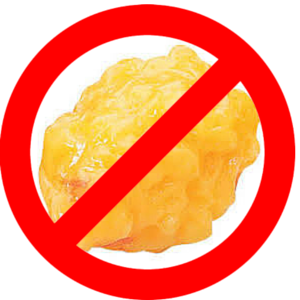
SECRET to Inhibit Fat Storage After Bad Day of Eating:
Here's what you do... following a day or night of careless eating, for the next 24 hours you follow a very low carbohydrate diet. That means not only following all the guidelines in this article, but taking them one step further. For 24 hours do NOT eat grain, fruit, nuts, dairy, sugar or alcohol whatsoever. You should stay under 30 grams of total carbohydrates for the entire 24 hour period. Basically you'll be eating protein and veggies, that is all.
This will limit fat storage from your 'off the wagon' night. Essentially, you're taking away the ingredients your body needs to store excess energy as fat - sugar and insulin.
Please do not make the mistake of thinking this a trick to compensate for a lifestyle of gluttony, you can easily find yourself on the express lane to an eating disorder. This is only meant to be a strategy for slip ups or planned social events.
Google Hangout Reveals 6 Secrets For Avoiding The 'Freshmen 15'
How realistic is it to expect students to be proactive and make better decisions about what they eat? This google hangout revealed 6 important takeways.
Tips 24-30
- Choose your college wisely - some are much easier to eat healthy at than others
- Think and plan, keep healthy list of meals & snacks in your fridge, room, bag, purse
- Be a leader, make health a priority and don't let your roomates bad habits ruin your good ones
- Eat a protein-rich meal before you go out to party - protein smoothies in a pinch!
- Stay active and get 7-8 hrs sleep, this won't cause weight loss, but will prevent weight gain
- Dating can derail your good food intentions, be the leader, if they're worth it they'll follow!
- When you have a day of partying, on the next day limit carbs to 30 grams or less to limit fat storage
'6 Minute' Weight Maintenance Workout You Can Do Anywhere
Well... it's really a '7 minute workout' that probably takes more like 9 or 10 minutes... I just always wanted to steal that 6 minute idea from Ben Stiller in 'Something About Mary', you know... '6-minute abs'? Okay I realize that most of you were like 2 or 3 years old when that movie came out but it's a classic and you should definitely put it on your movie night list.
Here's the thing, based on the latest science, you only need a few minutes of intense exercise 3-4 times per week to substantially reduce your chances of insulin resistance, obesity and chronic disease. No gyms, trainers or special equipment or even workout shorts needed.
This workout is known as the 'Scientific 7 Minute Workout', and it's the answer to every overworked executive, stay-at-home mom or college student's prayers. In my experience, it takes closer to 9 minutes, but if you weren't capable of setting aside less than 10 minutes, 3 to 4 times per week for a little bit of exercise, then you wouldn't have made it this far into the article.
Do each of these exercises for 30 seconds, with 10 seconds rest in between. There are numerous 7 minute workout apps you can dowload too. We think you'll be amazed at how much impact these 7 little minutes,, a few times per week, can have on your life.
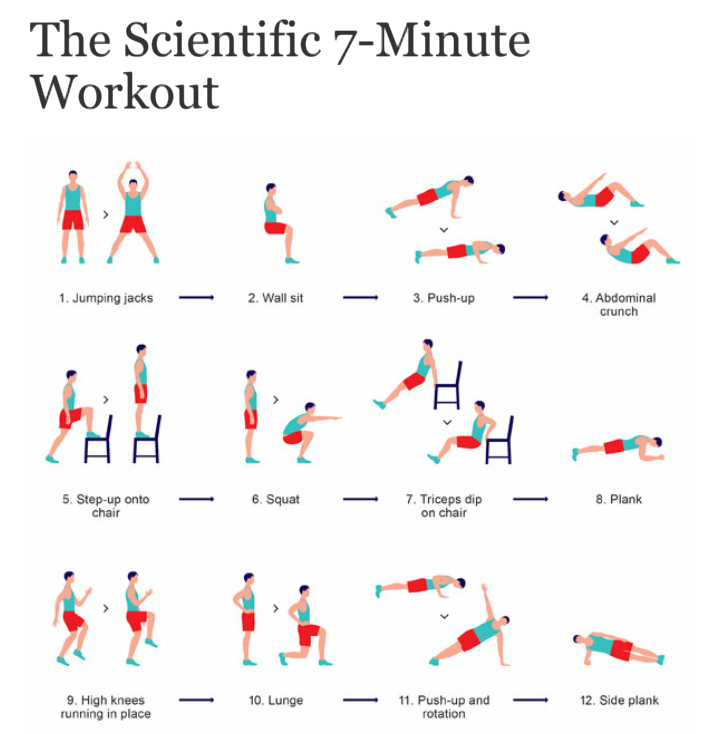
Hey look... if you can get to the gym on a regular basis in the face of your class schedule, study time, social events, touche! But for the rest of us... this 7 minute workout is a health-preserving gem that can fill the gap.
Tips 31-33
- Staying active is a powerful strategy to limit weight gain, but you can still do serious damage to your health by eating poorly even if you do workout regularly
- 3-4 short sessions of resistance & circuit training weekly is scientifically demonstrated to be as beneficial as daily endurance training
- The Scientific 7 Minute Workout is a simple, convenient and butt kicking routine that eliminates any possible excuse you could have for not getting exercise in college
Eye-opening Reading List That Debunks Much of What is Still Unfortunately Taught in Schools
Just what you were looking for right... more books to read? Well, if you have any discretionary assignments that involve choosing a health-related book to review, this is a great place to start.
But either way, you will get a powerful, health-enhancing and most likely life-extending education on how to eat for the rest of your lives by understanding the concepts in these books.
Fat Chance, Robert Lustig, M.D.
Dr. Lustig took a brewing consensus among thought leaders to a very public level with his New York Times Best Seller, 'Fat Chance'. This book takes you through the politics and societal dilemmas leading to an influx of sugar-based foods into most American homes beginning back in the 70's.
Glycemic Load Diet, Rob Thompson, M.D.
A very practical approach to planning and eating meals to allow you to avoid the insulin resistance epidemic. Aside from the typical misinformation on beer (Dr. Thompson mistakenly puts beer on top of his glycemic index, as do most diet books), this is a helpful book for specific tactics and food lists for minimizing the impact of processed carbs in your diet.
Grain Brain, David Perlmutter, M.D.
This book comes across as an all out assault on grain, sugar and carbohydrates in general. However, it's actually a well-presented argument based on clinical experience using very low carbohydrate protocols to treat various neurological disorders. The point for the general public, is that if clinical experience and science is linking mental decline to an over-indulgence in grains and sugars, we might want to pay attention to that you think?
Death by Food Pyramid, Denise Minger
If there was ever a voice of reason among the tribal feuds in 'nutritionland', it's Denise Minger. No medical credentials here, just an impressive knack for dissecting clinical trial data and history, which allows the reader to cut through the manipulations of various food pundits, some of whom, for example. would have you believing the China Study is the ultimate damnation of meat. Denise begs to differ... and if you can keep up with her relentless wit and mastery of English, you will come away with a dumbness vaccination that allows you to see through biased claims and manipulation of data, to arrive at something much closer to truth and usable science.
The Anti-inflammation Zone, Barry Sears, M.D.
You might have heard of the Zone Diet, which made Dr. Sears famous with his highly successful diet plan. This book drills down further into the effect of an overly processed food system, namely something called systemic inflammation. Basically our bodies are like smoldering coals, and the burnout leads to obesity, diabetes, cancer and mental decline.
33 Tips to Eat Healthy in College PDF
Enter your text here...
